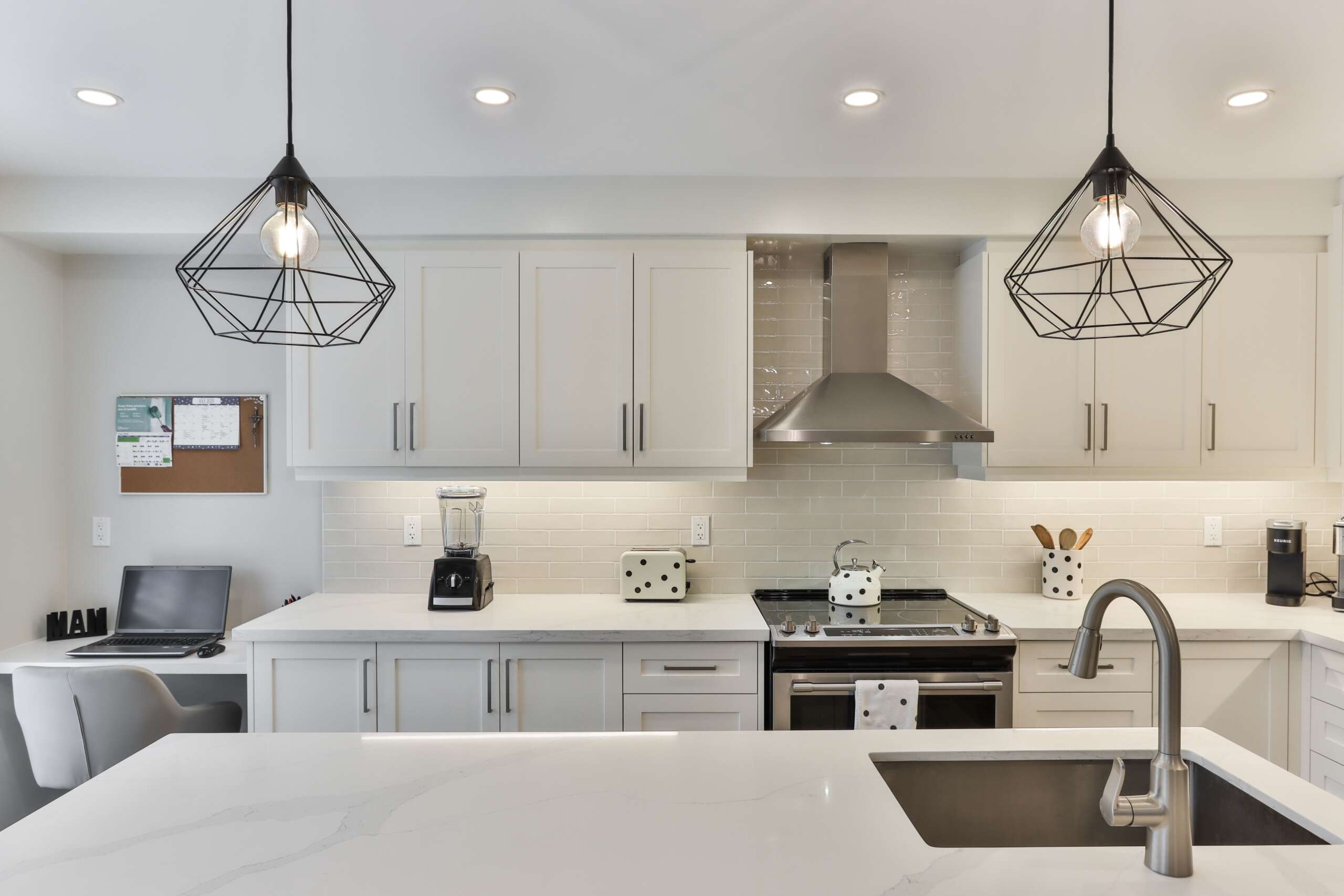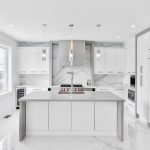Porcelain and Quartz Countertops for Your Unique Kitchen and Bath Design
Kitchen remodeling becomes essential when your kitchen countertop is old and out of style, or it is revealing signs of wear and tear for years of service to family gatherings and exposure to sun or chemical cleaners. There is a variety of materials to choose from for the countertop, but Quartz and Porcelain are the most popular. They both are engineered stones, but each has its own character that influences your kitchen’s feel and performance.
In this article, we compare Quartz and Porcelain as countertop materials and investigate four properties that influence their look and performance so you can make an informed decision for your kitchen that meets your needs as well as your style.
Contents
How Quartz and Porcelain look and perform as kitchen countertop?
When comparing materials for Kitchen remodeling, you need to know what they are made of. Quartz is a natural stone consisting of silicon and oxygen. It is the second abundant material in the continental crust of our earth. It is mined and ground, then mixed and pressed with resins in 90% to 10% ratio to produce a slab. Added resins are mainly epoxy and polyester but UV absorbers, stabilizers, peroxide, and coloring chemicals are mixed in to create different patterns and properties. The thickness of slab is defined by market demand but ½ inch (12 mm), ¾ inch (20 mm), and 1 ¼ inch (30 mm) are achievable. The most popular format is 10 x 5 feet (3040 x 1440 mm), but size can be customized for your kitchen island.
On the other hand, Porcelain (or fine china) is made from baking ceramic clay in high temperatures ranging from 2200 Fahrenheit to 2600. The clay is made of minerals such as Kaolinite, Feldspar, and Silica that provide strength and color to the finished product. Pigmented glazes are also added before baking to create different surface patterns. The thickness of the slab is generally ¼ inch (6 mm) to ½ inch (12 mm), and the format is at most 10 feet (3040 mm) by 5 feet (1440 mm).
They both have many features to make them a great choice for a kitchen countertop, but the following four factors make the biggest difference:
Strength:
Quartz is one of the hardest materials on earth, making it most resistant to wear and tear and ideal under mechanical stress. Its integrity is not vulnerable to scratches and cracks. It is also cost-effective because you don’t have to replace the whole countertop so often. Its surface becomes naturally sealed in production process against contamination and staining; thus, daily cleaning does not require any chemicals, and dishwashing liquid is enough to wipe the surface. You have to keep away any acidic or alkaline chemical, tough as they can affect the sealing integrity and leave behind a dull spot. Oven cleaners, as well as citrus fruits, are common threats.
On the other hand, the high temperature of baking process makes Porcelain a very strong and durable stone. Due to the glazing process, it is most resistant against staining caused by liquids such as coffee and red wine and chemicals like household cleaners or acidic foods. Most importantly, the non-porous surface makes it safe against germs in a kitchen countertop’s high traffic environment. When it comes to heavy objects though, you must be careful not to hit or drop them as it is vulnerable under mechanical stress. Everyday cleaning is more flexible as it works well with neutral solutions but keeps away hydrofluoric acid found in some toilet and aluminum cleaners!
Heat Tolerance
Sun exposure plays a significant role when choosing a kitchen countertop. Quartz is not able to withstand high sun exposure, and it will fade gradually, making it less ideal for outdoor kitchens. It is sensitive to thermal stress above normal kitchen ranges; therefore, trivet or hot pads are always needed under very hot pots and objects. You have to be careful with deep fryers, crock pots, and electric pressure cookers as they transfer heat to countertop.
Whereas Porcelain is heat-treated in the production process; therefore, it becomes heat and UV resistant, ideal for outdoor kitchens and indoor ones that are constantly exposed to sunlight through the windows. It is most effective in contact with hot pots and does not emit harmful chemicals into the air.
Beauty
Quartz, as a natural stone has marble veins running all the way through its thickness. It is dynamic and has a 3D depth that enhances style of every kitchen. It has many finishing options such as natural (leathered), polished (glossy), honed (matte), and rough (sandy). But Seams are more visible specifically with light colors. Porcelain can be made to look like marble in the production process by adding glazes to the surface. So its aesthetic consistency is more visible because the stone’s pattern is designed and printed with purpose and precision.
This feature provides you with customization and personalization opportunities to match the countertop to your kitchen’s overall design. Even patterns such as wood can also be achieved by design. But the popular marble veining is not full-bodied and does not run through the entire thickness of the slab. To overcome this issue, mitered edge is often chosen to create illusion of thickness. It has limited finishing options as only gloss or matt are achieved at the end of the baking process, but they make it water-proof, stain-resistant and low maintenance.
Edging Options
Quartz has many edging options that hugely impact the style of your kitchen. Depending on your choice, they can add sophisticated details or classic feel to your style’s tone. Edging options such as Straight, half and full Bullnose, half Bevel and quarter Round are classic while DuPont, Ogee, Double Bullnose, Chiseled and Cove DuPont are more sophisticated and Laminated Ogee, Mitered, Laminated Bullnose, Ogee Straight, and Cove Dupont/Ogee are best of both worlds adding more details to the good old classics.
But Porcelain can only be squared or mitered in the edges that limit the styles you can add to your kitchen. Due to its thinness, a mitered edge is often preferred to create a thicker-looking slab.
CONCLUSION
Quartz and Porcelain are both great options as a kitchen countertop, and only your personal style and circumstances determine your choice. considering the following pros and cons:
Quartz pros:
Quartz has the highest durability and strength, which is a great point in terms of investment. It has a beautiful natural marble look and offers many edging options as well as verity of finishes, thickness and sizes that help you create your dream style.
Quartz cons:
It is less tolerant to heat, sun exposure and chemical stress so extra caution is needed on regular contact and cleaning. Seams are also difficult to hide in light colors.
Porcelain pros:
Porcelain has the most resistance under heat and sun rays so it is the perfect choice for an outdoor kitchen. It is also stain-proof, germ-proof, and flexible with cleaning solutions; thus, everyday contact and cleaning is not a hassle.
Porcelain cons:
It has less strength under mechanical stress, so you have to be cautious with heavy objects. It lacks depth and natural marble look and only offers two edging options. Thickness, size, and finishing options are also limited; therefore, you face limitations to create the kitchen of your dreams.
An expert in Kitchen remodeling in Mission Viejo can help you make the best choice for your kitchen countertop that enhances your style and adds to your property’s value. Since Porcelain slabs are mainly imported from European countries such as Spain and Italy, they greatly impact your budget and investment. Only an interior designer with experience in Kitchen remodeling in Mission Viejo can help you decide which option has the most return on your investment.


